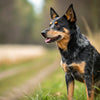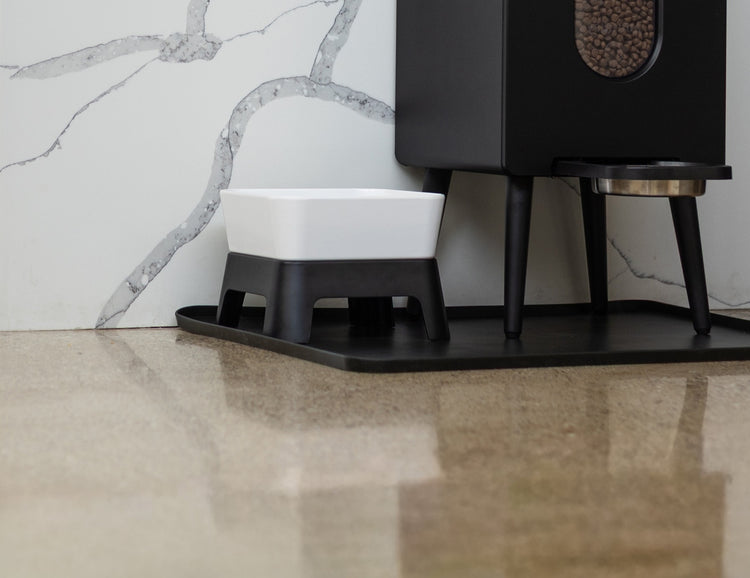Understanding the Harrier Temperament: A Comprehensive Guide
- Houndsy
Table of Contents
- Introduction
- The History and Characteristics of the Harrier Breed
- Key Aspects of Harrier Temperament
- Training and Socialization Needs
- Compatibility with Families and Other Pets
- Caring for a Harrier
- The Benefits of the Houndsy Kibble Dispenser for Harrier Owners
- Conclusion
- Frequently Asked Questions (FAQ)
Introduction
Imagine a dog that embodies the spirit of adventure, companionship, and playfulness. The Harrier, a breed often overshadowed by its more popular relatives like the Beagle and the English Foxhound, possesses a unique temperament that makes it a delightful addition to any active household. Did you know that Harriers were originally bred to hunt in packs, which shapes their sociable nature? In this blog post, we will dive deep into the Harrier temperament, exploring its characteristics, training needs, compatibility with families, and much more.
As dog lovers and owners, understanding the temperament of our furry friends is vital to ensuring a harmonious home. By the end of this article, we aim to equip you with a comprehensive understanding of what makes Harriers tick, how to manage their energetic spirit, and how our flagship product, the Houndsy Kibble Dispenser, can simplify your pet care routine.
We’ll cover:
- The history and characteristics of the Harrier breed
- Key aspects of Harrier temperament
- Training and socialization needs
- Their compatibility with families and other pets
- How to care for a Harrier
- The benefits of the Houndsy Kibble Dispenser for Harrier owners
So, are you ready to learn more about the charming Harrier temperament? Let’s embark on this journey together!
The History and Characteristics of the Harrier Breed
The Harrier is a medium-sized hound that traces its origins back to medieval England, where it was primarily used for hunting hares and foxes. It is believed that the first packs of Harriers were established as early as 1260, showcasing their long-standing history as a hunting companion. The breed was developed for its keen sense of smell, stamina, and ability to work cooperatively in packs.
Physical Characteristics
Harriers typically stand between 19 to 21 inches tall and weigh between 45 to 65 pounds, making them sturdy but not overly large. They have a short, dense coat that comes in various colors, including tri-color (black, tan, and white), red and white, and lemon and white. Their expressive eyes and long, drooping ears contribute to their charming appearance.
Key Attributes
- Energetic: Harriers were bred for hunting, so they possess a high energy level and require regular exercise.
- Scent Hounds: Their remarkable sense of smell drives their inquisitive nature, making them prone to following scents.
- Sociable: As pack animals, Harriers thrive on companionship, whether from humans or other dogs.
Understanding these characteristics lays the groundwork for appreciating the unique temperament of the Harrier.
Key Aspects of Harrier Temperament
The Harrier temperament can be described as friendly, outgoing, and playful. Here are some key traits that define their personality:
1. Playful and Energetic
Harriers are known for their love of play and activity. Their hunting background means they have a strong drive to chase and explore, making them excellent companions for families who enjoy outdoor activities. Regular exercise is essential to keep them stimulated and happy.
2. Friendly and Sociable
One of the most endearing aspects of the Harrier temperament is their friendliness. They are typically good with children and get along well with other dogs. However, due to their hunting instincts, they may view smaller pets, like cats or hamsters, as prey. Early socialization is crucial to ensure they develop positive relationships with other animals.
3. Vocal and Expressive
Harriers are known for their vocalizations. They communicate through various sounds, including moans, groans, and barks. This expressiveness can be charming, but it’s essential to manage their vocal tendencies, especially if you live in a noise-sensitive environment.
4. Independent Thinkers
While Harriers are eager to please, they also possess an independent streak. This trait can make training a bit challenging. They may sometimes choose to follow their instincts rather than obey commands, so consistency and positive reinforcement are vital in their training.
5. Affectionate and Loyal
Harriers are loving companions who thrive on human interaction. They enjoy being part of the family dynamic and often seek affection from their owners. This loyalty makes them wonderful family pets, as they bond closely with their human companions.
Training and Socialization Needs
Training a Harrier requires patience and consistency, given their independent nature. Here are some tips to ensure effective training:
1. Start Early
Begin training and socialization as early as possible. Expose your Harrier puppy to various environments, people, and other animals to help them develop into a well-adjusted adult.
2. Use Positive Reinforcement
Harriers respond best to positive reinforcement methods. Use treats, praise, and play as rewards for good behavior. This approach builds trust and encourages them to associate training with positive experiences.
3. Be Consistent
Consistency is key when training a Harrier. Use the same commands and cues every time, and ensure all family members are on the same page regarding training methods.
4. Engage in Mental Stimulation
Incorporate mental challenges into your Harrier’s routine. Puzzle toys, scent games, and interactive play can help keep their minds sharp and prevent boredom.
5. Consider Professional Training
If you find training a challenge, consider enrolling your Harrier in a professional training class. Obedience classes can provide structure and socialization opportunities while reinforcing good behavior.
Compatibility with Families and Other Pets
Harriers make excellent family pets due to their friendly and sociable nature. Here’s how they typically interact with children and other animals:
1. Great with Kids
Harriers are generally gentle and patient with children, making them a good choice for families. However, supervision is essential, especially with younger kids, to ensure safe interactions.
2. Social with Other Dogs
Being pack animals, Harriers usually enjoy the company of other dogs. They thrive in multi-dog households and often play well with their canine companions.
3. Caution with Small Pets
While Harriers can coexist with non-canine pets, it’s advisable to supervise their interactions. Their strong prey drive may lead them to chase smaller animals if not properly socialized.
4. Ideal for Active Households
Families that enjoy outdoor activities, such as hiking, running, or playing fetch, will find a perfect companion in a Harrier. Their energetic disposition makes them a great match for active lifestyles.
Caring for a Harrier
Owning a Harrier involves meeting their unique needs to keep them healthy and happy. Here are some essential care tips:
1. Regular Exercise
Harriers require ample exercise to burn off their energy. Aim for at least one hour of vigorous activity each day. This can include walks, jogs, or play sessions in a securely fenced yard.
2. Grooming Needs
The short coat of a Harrier is relatively low maintenance. Regular brushing (once a week) helps keep their coat healthy and reduces shedding. Check their ears weekly to prevent infections, and keep their nails trimmed.
3. Balanced Diet
Feed your Harrier a high-quality, balanced diet appropriate for their age and activity level. Consult with your veterinarian to determine the best feeding plan.
4. Regular Veterinary Care
Routine veterinary check-ups are essential to monitor your Harrier’s health. Keep up with vaccinations, parasite prevention, and dental care to ensure a long, healthy life.
5. Mental Stimulation
In addition to physical exercise, provide mental stimulation through training, puzzle toys, and scent games. This helps prevent destructive behavior and keeps your Harrier engaged.
The Benefits of the Houndsy Kibble Dispenser for Harrier Owners
Feeding time is a vital part of your Harrier's daily routine, and we at Houndsy understand how important it is to make it convenient and enjoyable. Our flagship product, the Houndsy Kibble Dispenser, is designed to enhance your pet feeding experience while aligning with the needs of active breeds like the Harrier.
1. Perfect Portion Control
With the Houndsy Kibble Dispenser, you can ensure your Harrier receives the right amount of food every time. Our precise portion control system eliminates the guesswork and helps maintain your dog's ideal weight.
2. Ergonomic Design
The dispenser features a convenient crank at standing height, so you no longer have to bend down to fill your dog's bowl. This ergonomic design is perfect for busy pet parents who want to simplify their feeding routine.
3. Stylish Home Decor
Our mid-century modern design not only enhances your pet's feeding experience but also complements your home decor. The Houndsy Kibble Dispenser is a beautiful addition to your kitchen or dining area.
4. Large Storage Capacity
With a capacity of 25-30 lbs, the Houndsy Kibble Dispenser minimizes the frequency of refills, allowing you to focus on spending quality time with your Harrier rather than worrying about feeding logistics.
5. BPA-Free Liner
The internal liner is BPA-free, ensuring that your Harrier's food stays fresh and safe. This is especially important for maintaining the quality of your dog's diet.
6. 30-Day Risk-Free Guarantee
We stand behind the quality of our product, which is why we offer a 30-day risk-free guarantee. You can try the Houndsy Kibble Dispenser, and if it doesn't meet your expectations, simply return it for a full refund.
By integrating the Houndsy Kibble Dispenser into your daily routine, you'll not only streamline feeding time but also enhance your overall pet care experience.
Conclusion
The Harrier temperament is a delightful combination of playfulness, friendliness, and independence. Understanding their unique characteristics is essential for providing a loving and stimulating environment that meets their needs. With proper training, socialization, and care, Harriers can thrive as cherished family members.
As you embark on this journey with your Harrier, consider how the Houndsy Kibble Dispenser can simplify your feeding routine and enhance your pet care experience. By prioritizing your Harrier's well-being, you can foster a strong and lasting bond that brings joy to both you and your furry friend.
Frequently Asked Questions (FAQ)
What is the average lifespan of a Harrier?
The average lifespan of a Harrier is between 12 to 15 years, depending on their overall health and care.
Are Harriers good with children?
Yes, Harriers are generally good with children and are known for their friendly and playful nature. However, supervision is always recommended during interactions.
Do Harriers require a lot of exercise?
Yes, Harriers are energetic dogs that require at least one hour of vigorous exercise each day to keep them happy and healthy.
How do I train a Harrier?
Training a Harrier requires consistency, patience, and positive reinforcement. Start early, use rewards, and engage in regular socialization to help them become well-adjusted adults.
Can Harriers live in apartments?
Harriers are not recommended for apartment living due to their high energy levels. They thrive best in homes with access to a large, securely fenced yard.
How can the Houndsy Kibble Dispenser help with feeding my Harrier?
The Houndsy Kibble Dispenser offers perfect portion control, ergonomic design, and a stylish appearance, making feeding your Harrier more convenient and enjoyable.













